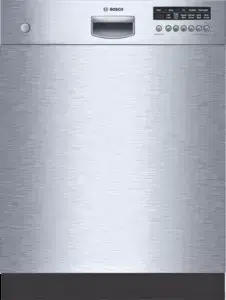Documents: Go to download!
User Manual
- User Manual - (English, French, Spanish)
- Instructions Manual - (English)
- Installation Instruction - (English)
- Dishwasher Components
- Dishwasher Features and Options
- Dishware Materials
- Preparing and Loading the Dishware
- Adding Detergent and Rinse Agent
- Operating the Dishwasher
- Care and Maintenance
- Self Help
Table of contents
User Guide Dishwasher
Dishwasher Components
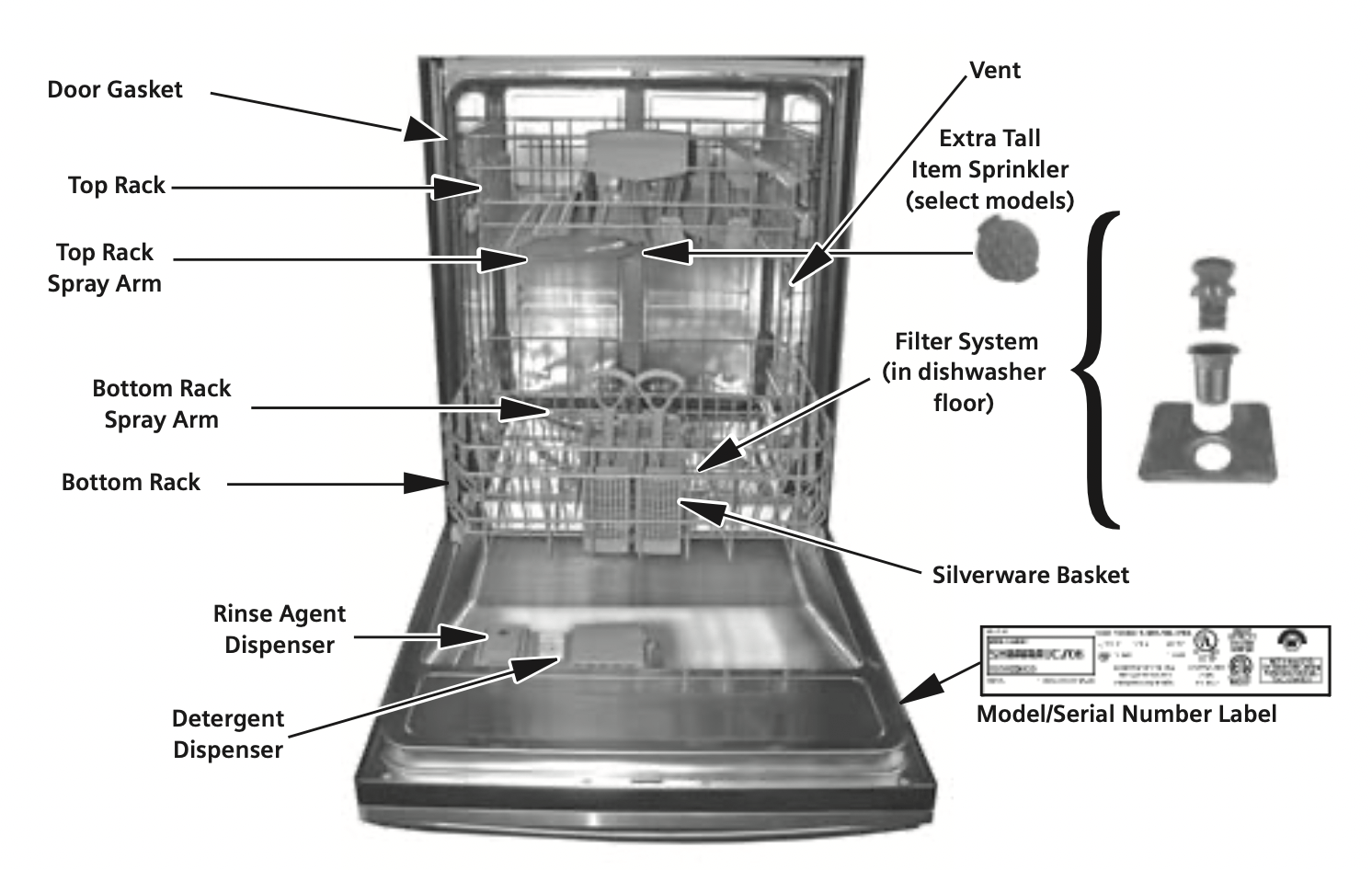
Dishwasher Features and Options
Noise Reduction System: a two-pump motor system, the suspension Motor™, and triple insulation make this dishwasher one of the quietest in north america.
Stainless Steel TALLTUB™: a rust-free, hygienic interior surface with a lifetime warranty.
Nylon Coated Racks: Eliminate cuts and nicks, and have a five-year warranty.
Flow-Through Heater™: Heats water to a temperature of up to 161°f.
Condensation Drying: A high temperature final rinse, a low temperature stainless steel tub, and the sheeting action of a rinse agent result in drying that is hygienic, energy efficient, and economical.
SENSOTRONIC™ Water Condition Monitor: Checks water condition and decides whether a second fresh water fill is necessary.
Filter System: Three filters ensure distribution of clean water and protect the main pump and the drain pump from foreign material.
Water Shut-Off: A safety feature that stops the flow of incoming water, if water is detected in the base of the dishwasher.
Delay Start: this option allows you to delay the start time of your dishwasher.
Upper Rack & Lower Rack Flip Tines: flip tines fold down to make loading the racks easier in some instances.
Half Load: reduces the energy and water consumption when washing small, lightly soiled loads.
Extra Dry Heat: raises the temperature of the rinse water and increase the drying time which will result in improved drying OPTIDRY: this feature senses when the unit is low on rinse agent and automatically increases the drying time.
Rackmatic Adjustable Rack Height: the top rack can be raised or lowered to accomodate tall items in the top and bottom racks.
Dishware Materials
NOTE: Before using your dishwasher for the first time, check the information in this section. Some items are not dishwasher safe and should be hand-washed; others require special loading. Contact the item’s manufacturer if you are unsure about the item’s dishwasher suitability.
Recommended
Aluminum: Colored anodized aluminum may fade over time. Minerals in your water may cause the aluminum to darken or spot. This can usually be removed by using a soap-filled steel wool pad.
China, Crystal, Stoneware: some hand-painted pieces may discolor, fade, or spot. Hand-wash these pieces. position fragile glassware so that it will not topple over or contact other pieces during the wash cycle.
Glass: Milk glass may yellow.
Non-Stick Coatings: apply a light coating of vegetable oil to non-stick surfaces after drying. Plastics: Make sure the piece is dishwasher safe.
Stainless Steel, Sterling Silver, and Silver Plate: place these pieces so that they do not contact dissimilar metals.
Not Recommended
Acrylic: Crazing (small cracks throughout the acrylic) may occur.
Adhesive-Joined Pieces: adhesives that join materials such as plastic, wood, bone, steel copper, tin, etc. may loosen.
Bone-Handled Utensils: Handles may separate.
Iron: Iron will rust. Hand-wash and dry immediately.
Non-Dishware Items: Your dishwasher is intended for use in cleaning onlY standard household dishware and kitchenware.
Pewter, Brass, Bronze: pewter will tarnish. Hand-wash and dry immediately.
Tin: tin will rust. Hand-wash and dry immediately.
Wood: Wooden bowls, wooden utensils, and wood-handled utensils can crack, warp, and lose their finish.
Preparing and Loading the Dishware
Dishware Preparation
Do not pre-wash items having loosely-attached soiling. remove large food particles, bones, seeds, toothpicks, and excessive grease. items having burned-on, baked-on or starchy soils may require pre-treatment.
Loading the Dishwasher
Check the Materials section of this manual if you are unsure about an item’s dishwasher suitability. load only dishwasher-safe items into the dishwasher. load dishes in the dishwasher racks so that the insides of bowls, pots, and pans are facing the spray arms. avoid nesting and contact points between dishes. separate items of dissimilar metals.
Loading the Top Rack
Figures 1 and 2 show typical 10 and 12 place load patterns for the top rack.
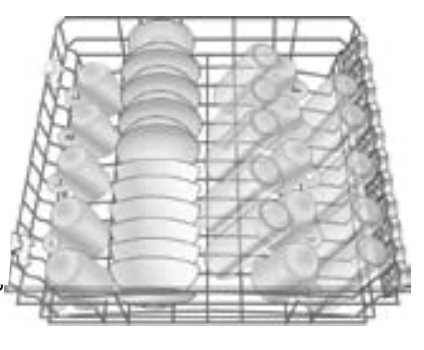
Figure 1: 10 place setting top rack
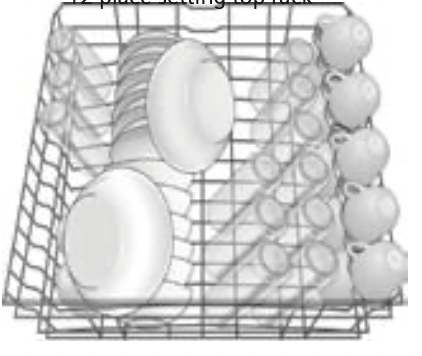
Figure 2: 12 place setting top rack
NOTE: Make sure items do not protrude through the bottom of the racks and block the spray arms.
NOTICE: To avoid dishwasher damage, do not load the dishwasher with objects such as paper products, plastic bags, packing materials, or anything other than normal dishware and kitchenware. Do not load the dishwasher with anything other than dishwasher-safe dishware and kitchenware.
Top Rack Accessories
Top Rack Flip Tines
Flip Tines fold down to make loading the racks easier in some instances. Grasp the tines, release from notch, and fold the tines downward. When the top rack is loaded, push it into the dishwasher.
NOTE: When pushing the top rack into the dishwasher, push it until it stops against the back of the tub so the top rack spray arm will connect to the water supply. Do not push the top rack with the door.
RACKMATIC™ Top Rack Height Adjustment
The top rack can be raised to accommodate items up to 8” (20cm) in the top rack and 14” (36cm) in the bottom rack, or lowered to accommodate items up to 10” (25cm) in the top rack and 12” (30cm) in the bottom rack. (See Figure 4 & 5)

Figure 4
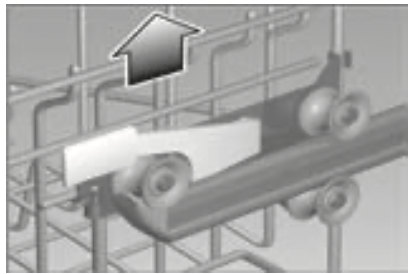
Figure 5
NOTE: Before you push the top rack back into the dish-washer, ensure that the rack height is the same on both sides. Otherwise, the dishwasher door will not shut and the top rack spray arm will not connect to the water circuit.
e) Push the top rack back into the dishwasher.
Loading the Bottom Rack
Place large items in the bottom rack. load pots, pans and bowls upside-down. Figures 6 and 7 show typical mixed loads for the bottom rack.
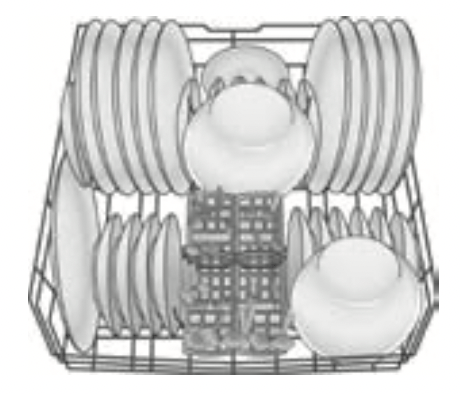
Figure 6: 10 place setting bottom rack
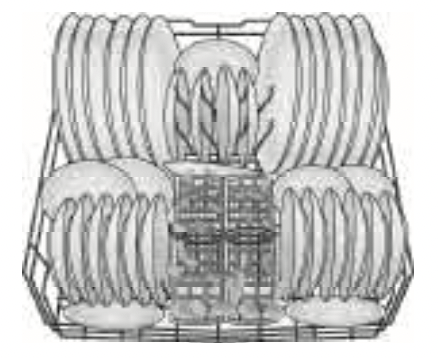
See other models: SHX7ER55UC/52 SHE55M06UC/52 WFL2060UC/32 SGE53U56UC/D5 SPV5ES53UC/20
Figure 7: 12 place setting bottom rack
Bottom Rack Flip Tines
Flip Tines fold down to make loading the racks easier in some instances. Grasp the tines and fold them downward.
Loading Extra Tall Items
If an item is too tall to be placed into the bottom rack even with the top rack in the raised position, remove the empty top rack by pulling it out of the dishwasher until it stops rolling. Pull the front of the rack upward and outward until the rollers are completely free of the roller guides. set the top rack aside. Push the roller guides back into the dishwasher. Insert the extra tall item sprinkler into the top rack spray outlet and turn the sprinkler clockwise to lock it into position as shown in figure 8. Place your extra tall item(s) in the bottom rack as shown in figure 9.

Figure 8
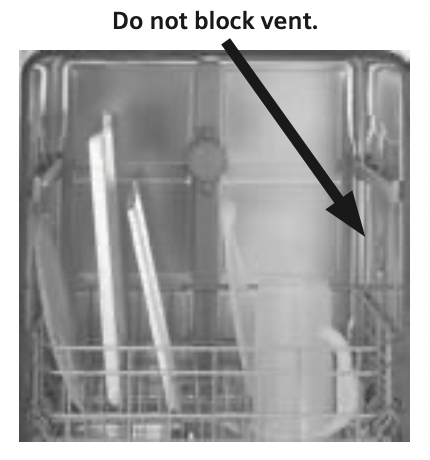
Figure 9
NOTE: Keep the vent on the tub’s right side clear by placing tall items such as plastic cutting boards and tall baking sheets on the bottom rack’s left side, center, or back.
NOTICE: To avoid dishwasher damage, do not reinstall the top rack without removing the extra tall item sprinkler. Do not reinstall the top rack with the sprinkler installed.
To remove the sprinkler and return the dishwasher to its normal condition:
- Turn the sprinkler counterclockwise and remove it.
- Retrieve the top rack.
- Tilt the top rack upwards and position the top rack rollers onto the roller guides.
- Continue pushing the top rack until the rollers are on the guide.
- Push the top rack into the dishwasher.
Loading the Silverware Basket
NOTE: The silverware basket tops can be folded up to accommodate large or oddly-shaped items.
With the silverware basket tops down, load the silverware basket following the patterns suggested in Figure11 (for flexible basket). Place knives with their handles up, and forks and spoons with their handles down.
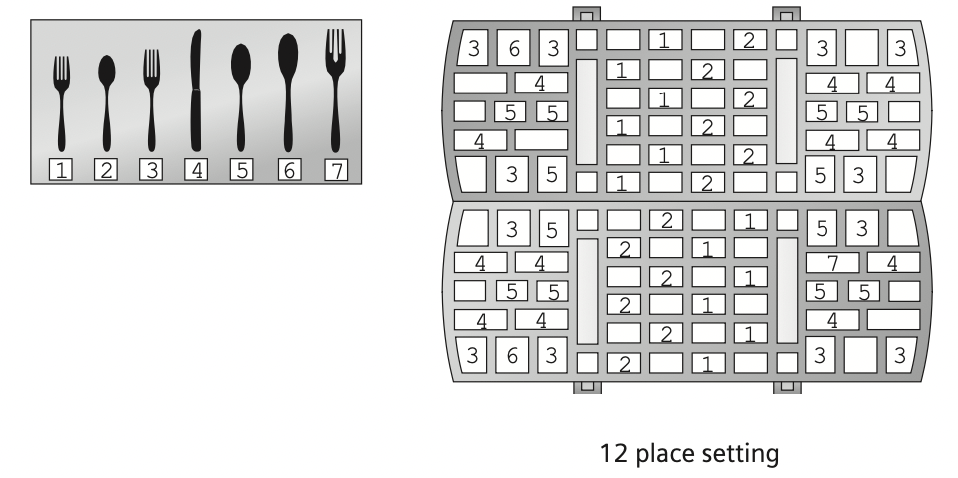
Figure 11
If large or oddly-shaped items are to be loaded into the silverware basket with the tops up, load the items so that they do not nest together. load knives and sharp utensils with their handles up.
CAUTION: The sharp points and edges of knives and other sharp utensils can cause serious injuries. Load knives and other sharp utensils with sharp points and edges down. Do not allow children to handle or play near knives and sharp utensils.
The Flexible Silverware Basket
This basket is designed for maximum versatility. The basket splits along its length, resulting in two halves that may be placed in a variety of positions in the lower rack, greatly increasing the lower rack’s loading versatility.
To split the Flexible Silverware Basket:
- Grasp the basket as shown in figure 12a, and slide the two halves in opposite directions, as shown in figure 12a.
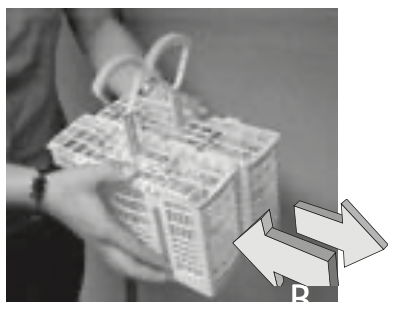
- Pull the two halves apart, as shown in figure 12b.
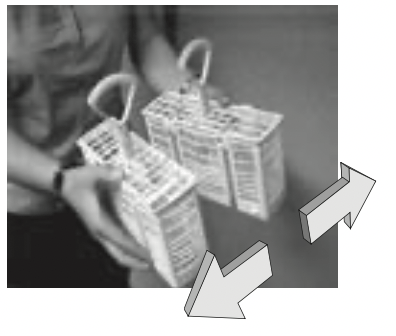
Some suggestions for placing the two halves in the lower rack are shown in figure 13.

Figure 13
Adding Detergent and Rinse Agent
Detergent
Use only detergent specifically designed for dishwashers. For best results, use fresh powdered dishwashing detergent.
NOTICE: To avoid dishwasher damage, do not use hand dishwashing products in your dishwasher.
This dishwasher uses less water so you need to use less detergent. With soft water, 1 tablespoon (15ml) of detergent will clean most loads. the detergent dispenser cup has lines that measure detergent to 1 tablespoon (15ml) and 1.75 tablespoons (25ml). 3 tablespoons (45ml) of detergent will completely fill the detergent dispenser cup.
NOTICE: To avoid dishware damage, do not use too much detergent if your water supply is soft. Using too much detergent in soft water may cause etching in glassware.
NOTE: If you do not know the hardness of your water supply, use 15ml of detergent. Increase the amount of detergent, if necessary, to the least amount required to get your dishware and kitchenware clean.
Use the measuring lines in the detergent dispenser cup as a guide to measure the amount of detergent recommended in table 1.
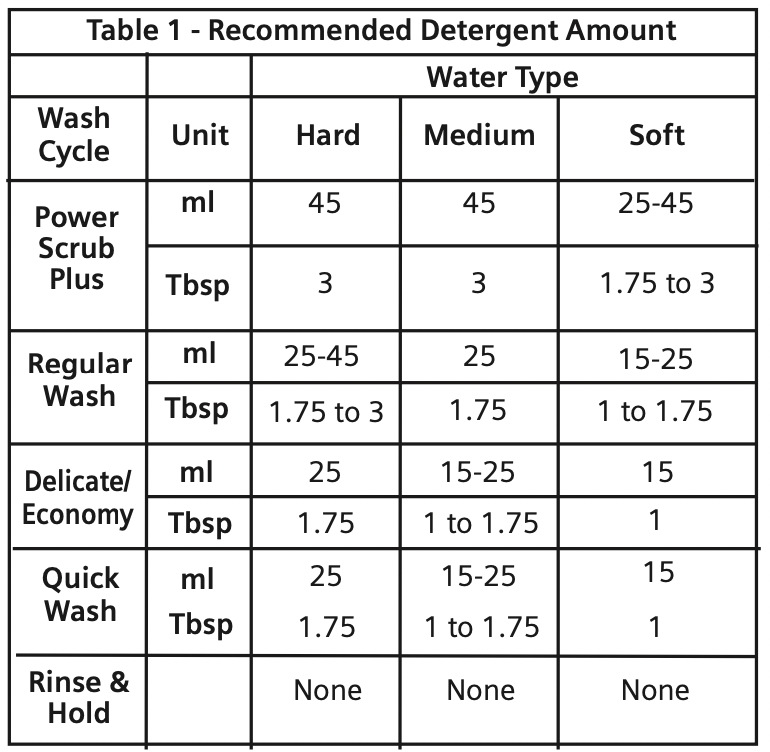
Filling the Detergent Dispenser
Fill the dispenser cup as recommend in table 1. ( see figure 14 for additional information.)
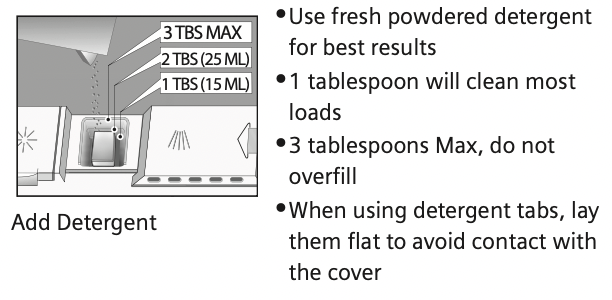
Figure 14
To close, slide the detergent dispenser cover in the direction shown in figure 15 and press it down firmly so the cover snaps shut.
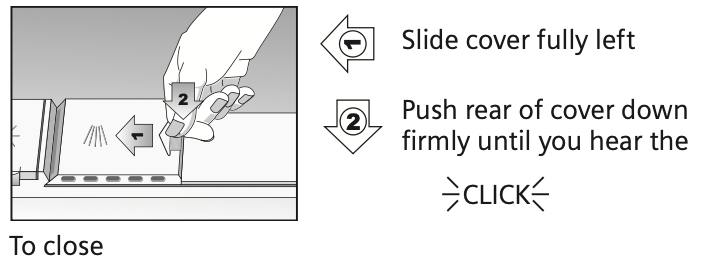
Figure 15
To open the detergent dispenser cover, press the blue release tab in the direction shown in figure 16. pressing down on the release tab will not open the cover.
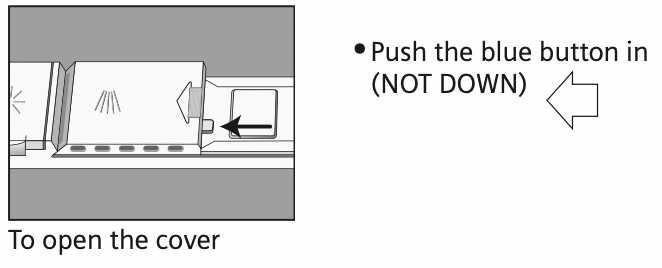
Figure 16
Rinse Agents
To achieve proper drying, always use a liquid rinse agent, even if your detergent contains a rinse agent or drying additive.
Rinse Agent Dispenser
Open the rinse agent dispenser by lifting the tab with your thumb as shown in figure 17.
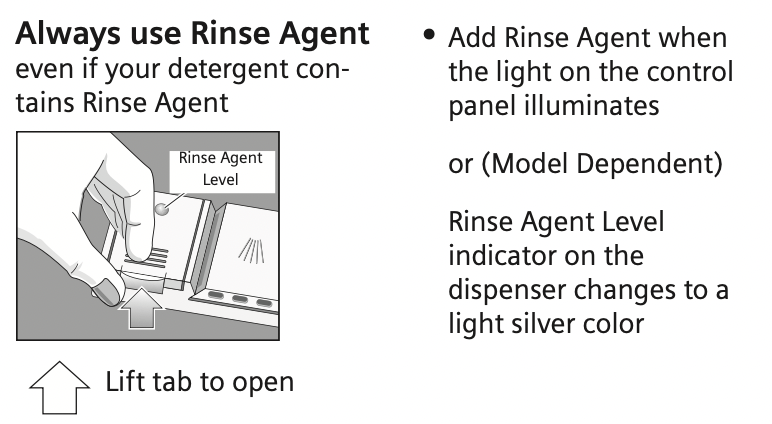
Figure 17
Add liquid rinse agent to the dispenser as shown in figure 18 until the rinse agent reservoir is full. Wipe up any excess rinse agent that puddles when the dispenser reservoir is full.
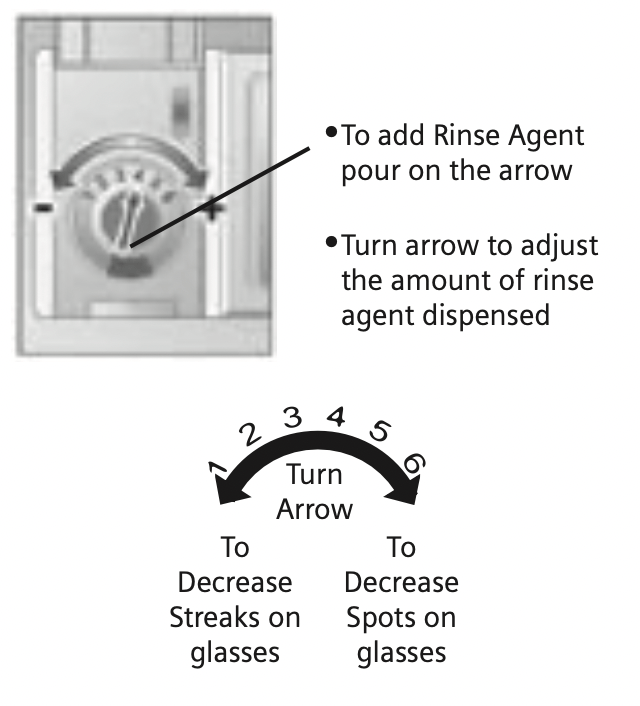
Figure 18
NOTE: The dishwasher indicates low rinse agent either by showing the symbol  in the countdown display, or illuminating the refill rinse agent light as shown in figure 19 (model dependent).
in the countdown display, or illuminating the refill rinse agent light as shown in figure 19 (model dependent).
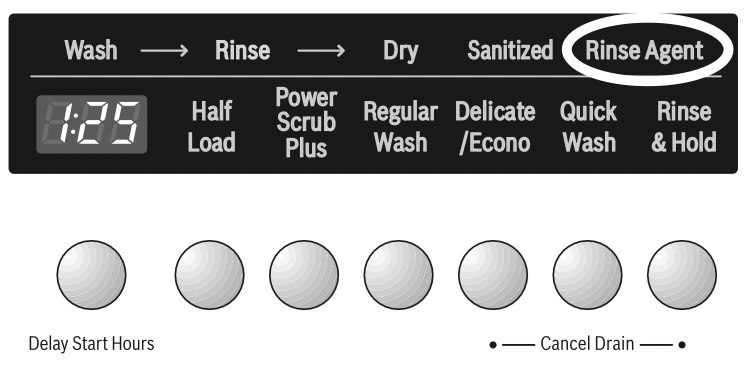
Figure 19
NOTE: After filling the rinse agent dispenser, the indicator light will go out in a few minutes after the dishwasher door is shut (select models).
Operating the Dishwasher
Always make sure your dishware is dishwasher safe. Refer to the Dishware Materials section of this manual for guidance.
Wash Cycles
Power Scrub Plus
Cleans items having baked-on or hard dried-on food soils. These items may require soaking or hand scouring.
Regular
Thoroughly cleans large loads having loosely attached normal soiling.
Delicate/Economy
For delicate or heirloom dishwasher and silverware or other special items. Always make sure that the items are dishwasher safe. Refer to the Materials section of this manual for further information. Hand washing may be the best treatment of such items.
Quick Wash
For lightly soiled items with easy to remove food soils.
Rinse and Hold
Allows you to rinse the food soil off of a partial load and hold them in the dishwasher until there is a full load.
More information on dishwasher cycles is located in the Wash Cycle information section of this manual.
Wash Cycle Options
Half Load
In the power scrub plus, regular and auto Wash cycles you can reduce the energy and water consumption when washing small, lightly soiled loads that fill approximately half of the dishwasher’s capacity. To activate, select the Half load button in addition to the power scrub plus, regular or auto Wash cycle button.
Extra Dry Heat
With this option you can raise the temperature of the rinse water and increase the drying time which will result in improved drying.
NOTE: The unit must be powered off before activating
To activate:
- Press and hold the left “Cancel / Drain” button (see Figure 20), then press and hold the on/off button.
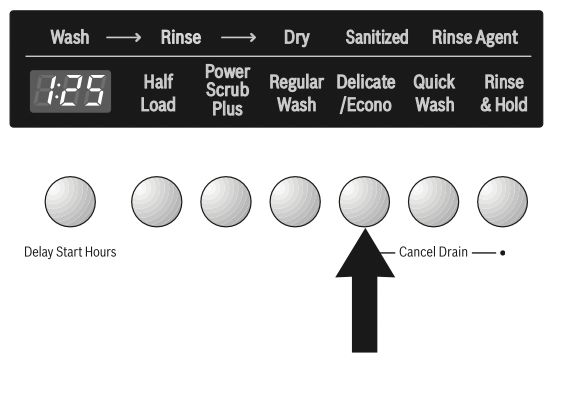
Figure 20
- When the LED display shows a “00” or a “01” release both buttons.
- To enable the Additional Drying Heat, press the left “Cancel / Drain” button until the LED
- display shows a “01”.
- To disable the Additional Drying Heat, press the left “Cancel / Drain” button until the LED display shows a “00”.
- Press the on/off button to save the setting.
Delay Start
This option allows you to delay the start time of your dishwasher.
To activate:
- Turn the dishwasher on.
- Select the desired wash cycle.
- Press and hold the Delay start button. Release when the desired delay time is shown in the display window.
OPTIDRY™
This feature senses when the unit is low on rinse agent and automatically increases the drying time. For best performance, always use a liquid rinse agent even if your detergent contains a drying additive.
Starting the Dishwasher
To start the dishwasher, follow the instructions in figure 21
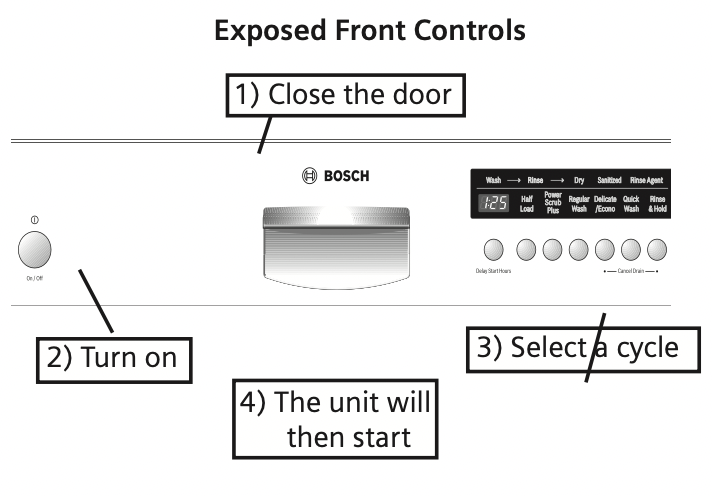
Figure 21
Interrupting a Cycle
NOTE: Should you need to interrupt a cycle (to add or remove an item, to add detergent, etc.), it is best to do so within the first 30 minutes of the cycle.
- Press the on/off button to turn the unit off.
- Wait at least ten seconds or until the water noises stop before opening the dishwasher door.
- To resume the cycle, close the dishwasher door and then press the on/off button.
WARNING: You could be seriously scalded if you allow hot water to splash out of the dishwasher. OPEN THE DOOR CAREFULLY during any wash or rinse cycle. Do not fully open the door until water noises have stopped.
Wait at least ten seconds or until water noises stop before opening the dishwasher door. To resume the cycle, press the on/off button and shut the dishwasher door.
Canceling or Changing a Cycle
To cancel or change a cycle, press and hold for three seconds the two buttons labeled “Cancel Reset” as shown in Figure 22.

Figure 22
Wait until the dishwasher completes the cycle (approximately 1 minute). Open the door and press the on/off button.
You may now begin a new cycle.
Dishware Drying
at the end of the cycle the dishwasher will stop and a period of condensation drying will follow. after drying, the cycle is complete and:
- the “Sanitized” light may appear. See section on Sanitization for more information.
- the countdown display will show “0” .
NOTE: If your household water supply is too hot, your dishwasher’s heating time may be reduced and the “Sanitized” light may not illuminate. Your Dishwasher Installation Manual has information on the recommended temperature for your household hot water supply.
NOTE: To accelerate and enhance drying, open the dishwasher door, pull the top rack a few inches out of the dishwasher, and prop the dishwasher door against the top rack.
Sanitized Light
When the sanitized light appears (see figure 23), it means that the dishware and kitchenware that was just washed has been sanitized according to the requirements of the national

Figure 23
Sanitation Foundation (NSF). For more information on NSF certification, refer to the Wash Cycle information section of this manual.
Unloading the Dishwasher
Unload the bottom rack first.
Unload the silverware basket(s). they are easily removed for unloading.
Unload the top rack.
If the extra tall item sprinkler was installed, return the dishwasher to its normal condition (see the Loading Extra Tall Items instructions in the “Loading the Dishwasher” section of this manual).
Care and Maintenance
Maintenance Tasks
Certain areas of your dishwasher require occasional maintenance. the maintenance tasks are easy to do and will ensure continued superior performance from your dishwasher. these tasks are:
- Winterizing Your Dishwasher
- Wiping up Spills and Splash-out
- Clean the Stainless Steel Inner Door and Tub
- Check/Clean the Spray Arm Nozzles
- Check/Clean the Filter System
- Clean the Exterior Door Panel
- Clean the Door Gasket
Winterizing Your Dishwasher
If your dishwasher will be unused for an extended period of time in a location that experiences freezing temperatures (e.g., in a holiday home or through a vacation period), have your dishwasher winterized by an authorized service center.
NOTICE: To avoid dishwasher damage, do not allow water to remain in your dishwasher systems through extended periods of freezing temperatures. Freezing temperatures can damage your dishwasher.
Wiping Up Spills and Splash-out
Water may occasionally splash out of your dishwasher, especially if you interrupt a cycle or open the dishwasher door during a cycle. To avoid floor damage and possible mold growth, do not allow wet areas to remain around or under the dishwasher.
Check/Clean the Stainless Steel Inner Door and Tub
Clean the outer edges of the inside door panel regularly to remove debris that might collect there from normal loading.
If spots begin to appear on the stainless steel tub or inner door, make sure the rinse agent reservoir is full.
Check/Clean the Spray Arm Nozzles
Occasionally check the spray arms to ensure that the spray arm nozzles (holes) are unobstructed. You must remove the spray arms to check them for obstruction.
To remove the top spray arm:
- Remove the empty top rack from the dishwasher.
- Turn the rack upside-down. the top spray arm is held in position by a locking nut as shown in figure 24A. Turn the locking nut counter-clockwise 1/8 turn and remove it, as shown in figure 24B to release the spray arm.
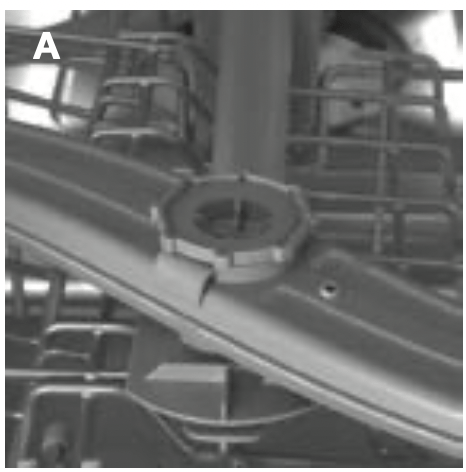
- Remove the spray arm as shown in figure 25.
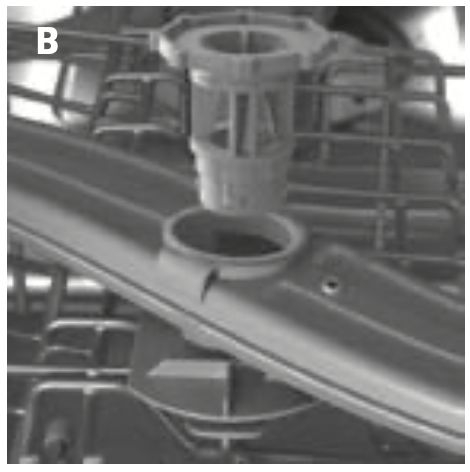
- Look for obstruction in the spray nozzles.
- If the spray nozzles need cleaning, flush them under running water.
To reinstall the top spray arm:
- Return the top spray arm to its installed position.
- Return the locking nut to its installed position and turn it 1/8 turn clockwise.
- Return the top rack to the top rack roller guides.
To remove the bottom spray arm:
- Remove the empty bottom rack from the dishwasher tub.
- Grasp and lift the bottom spray arm as shown in figure 26.
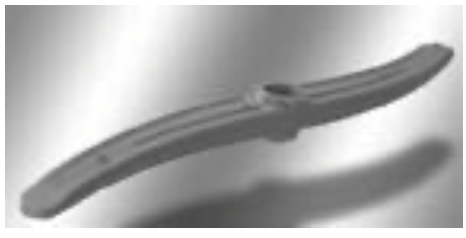
- Look for obstruction in the spray nozzles.
- If the spray nozzles need cleaning, flush them under running water.
To reinstall the bottom spray arm:
- Return the bottom spray arm to its installed position and press it so that it snaps into place.
- Return the bottom rack to its installed position.
Check/Clean the Filter System
This dishwasher has a filter system that consists of a Large Object Trap/Cylinder Filter assembly and a Fine Filter. Select models have an additional Micro Filter. The filter system is located on the inside of your dishwasher under the lower rack and is easily accessible.
During normal use, the filter system is self-cleaning. You should occasionally inspect it for foreign objects and clean it when necessary.
CAUTION: To avoid injury, do not reach into the large object trap with your fingers. The large object trap could contain sharp objects.
This dishwasher has a filter system that consists of a Large Object Trap/Cylinder Filter assembly and a Fine Filter. The filter system is located on the inside of your dishwasher under the lower rack and is easily accessible.
During normal use, the filter system is self-cleaning. You should occasionally inspect it for foreign objects and clean it when necessary.
To Remove the Large Object Trap/Cylinder Filter Assembly:
- Remove the bottom rack.
- Grasp the assemblyas shown in figure 27 and turn it counterclockwise 1/4 turn.
- Lift out the assembly as shown in figure 28.

- Carefully examine the assembly. If you find debris in the Large Object Trap, turn it upside-down and gently tap it on a surface such as a countertop to dislodge and remove the debris. Flush the Cylinder filter clean by holding it under running water.
To Remove the Fine Filter:
- Lift the Fine Filter from the dishwasher floor as shown in Figure 29 and flush it clean by holding it under running water.
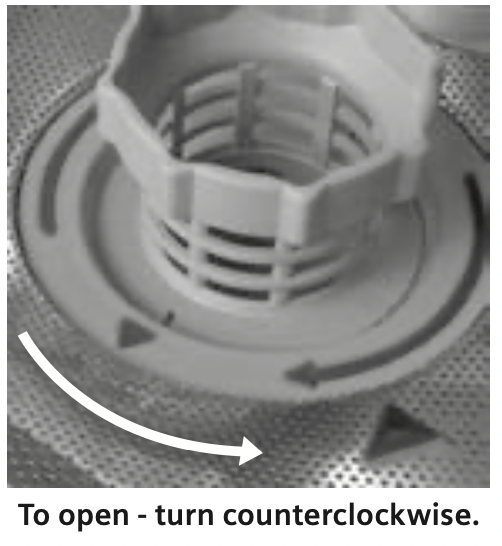
To reinstall the filter system:
- Return the fine filter to its installed position.
- Place the large object trap/Cylinder filter assembly into its installed position in the dishwasher floor.
- Turn the ring handle clockwise 1/4 turn until it is locked. The arrow on the ring handle and the arrow on the fine filter should point to each other, as shown by the circle in figure 30.
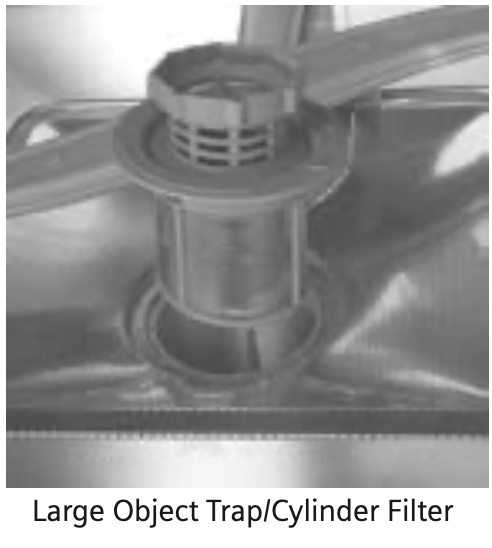
- Gently pull the ring handle to ensure that the assembly is locked into place.
NOTICE: To avoid possible diswasher damage, do not use harsh chemicals, abrasive cleaners, scouring pads (metal or plastic), or abrasive cloths/paper towels to clean your dishwasher’s exterior door panel. Your dishwasher’s exterior door panel can be damaged by doing so.
Clean the Exterior Door Panel
Colored Doors
Use only a soft cloth that is lightly dampened with soapy water.
Stainless Steel Doors
Use a soft cloth with a non-abrasive cleaner (preferably a liquid spray) made for cleaning stainless steel. For the best results, apply the stainless steel cleaner to the cloth, then wipe the surface.
Clean the Door Gasket and Door Seal
Regularly clean the door gasket with a damp cloth to remove food particles and other debris. Also clean the door seal, located inside the dishwasher at the bottom of the door.
Wash Cycle Information
NOTE: To save energy, this dishwasher has a “Smart Control” that automatically adjust the cycle based on soil loads and incoming water temperature. The “Smart Control” makes decisions that can cause the cycle time and water usage to adjust intermittently. The cycle times listed in the use and Care manual are based on normal soil loads and 120°f incoming water and will vary based on your actual conditions.
See the Cycles and Options Charts to determine the cycles available for your specific model.
NOTE: On select models, the Half load feature will reduce the water consumption by approximately 30 percent in the power scrub plus, and regular cycles.
Self Help
| Problem | Cause |
Action |
|---|---|---|
| Dishwasher does not start |
|
|
| Dishwasher beeping (end of cycle signal) |
Default factory settings alert the customer that the cycle has completed by beeping. This feature can be deactivated if so desired. |
To adjust the volume or deactivate, refer to “Cycle Completion Signal” section in this manual. |
| Display does not illuminate or console lights are not on |
Note: For models with controls on the top portion of the door, the display only illuminates when the door is opened and controls are visible. |
|
| Dishwasher seems to run a long time |
Note: Refer to “Cycle Chart Data” section in this manual for typical cycle length. |
|
| Dishes aren’t getting clean enough |
|
|
| Dishes are not getting dry enough |
Note: Plastic or Teflon do not typically dry as completely as other items due to their inherent properties. |
Note: Select models offer an extra heating options to improve drying performance. Refer to “Wash Cycle options” under the Operating the Dishwasher section of this manual. |
| Odor |
|
Note: If odor still persists, run the Normal/Regular cycle until it flushes and interrupt the cycle and place an 8 oz. cup of distilled white vinegar solution on the top rack and then finish the cycle. |
| Dishwasher not filling with water |
|
|
| Water Leaks |
|
|
| Tub stains |
|
|
|
Streaks on glassware or residue on the dishes |
Incorrect rinse agent setting. |
Depending on the hardness of water, adjust the rinse agent dispenser. Refer to “Adding Detergent and Rinse Agent” section in this manual for adjustment. |
|
Fascia panel discolored or marked |
Abrasive cleaner used. |
Use mild detergents with soft damp cloth. |
| Noise during wash cycle |
The dishes may not be arranged properly. |
Water circulation sound is normal, but if you suspect items are banging into each other or into the spray arms, refer to the “Preparing and Loading” section of this manual for optimal arrangement. |
|
Detergent dispenser cover will not shut |
|
|
|
Unable to select desired cycle |
Previous cycle has not finished. |
Refer to the “Canceling or changing the cycle” section of this manual. |
